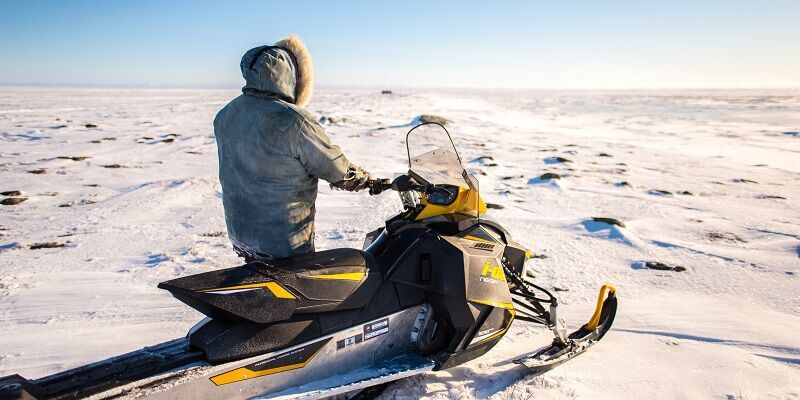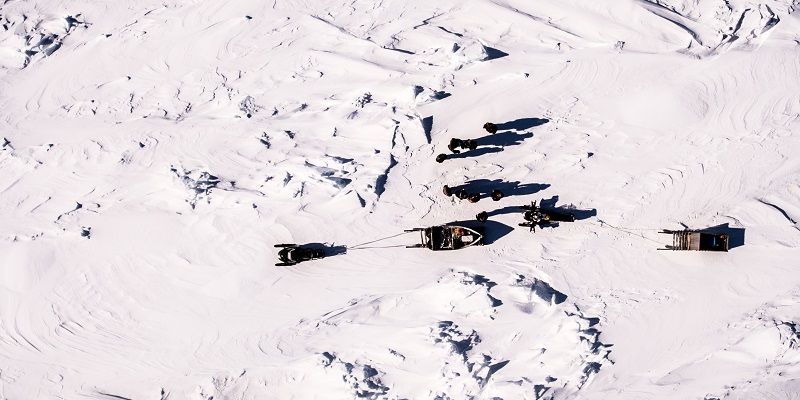
Inuit communities’ travel skills and regional knowledge have helped mitigate the effects of Arctic climate change on travel conditions, according to a new study.
The Arctic is warming nearly twice as quickly as the rest of the world and has the potential to affect many aspects of life for the people that live there.
The semi-permanent trails used by indigenous communities on sea ice, rivers and frozen ground are vulnerable to warming conditions which can cause sea ice melt and flooding. These trails are critically important for travel between settlements, to cultural sites and for practicing traditional hunting, fishing and gathering activities.
Until now, understanding whether climate change has affected the ability of Inuit to use these trails has been elusive, making it difficult for communities and regional and local governments to decide how to plan for climate impacts.
A study led by Professor James Ford, from the Priestley International Centre for Climate at the University of Leeds, used interviews with nine Inuit communities in the eastern Canadian Arctic to assess trail viability and compared this to 30 years’ worth of weather records to determine changes in travel conditions.
Researchers found that despite significant changes in climate-related conditions between 1985-2016, including warming temperatures, overall trail access was affected much less than they expected.
Trail access and travel days
The study, published in Nature Climate Change, suggests trail conditions have only changed by roughly one or two viable travel days in the last 30 years and that the combined number of suitable travel days per year for the three types of travel examined – over snow on land, over sea ice and on open water – has actually increased.
While changing ice conditions are reducing sea ice trail access for using snowmobiles in the autumn and winter, improvements in visibility and wind appear to be offsetting this by enhancing both land and water trails in the spring and summer.
To assess trail access and viable travel days the research team, for the first time, took into account the skill level and risk tolerance among trail users to determine viable travel days.
For example, ice concentration is critical for safely using small boats. Low or no ice concentrations are preferred by Inuit for boating. Accidents where boats have been sunk by ice strikes or occupants have been thrown overboard are more prevalent in high ice concentrations.
The study suggests that less than 30% ice coverage is generally preferred for boating. However, in determining thresholds for trail access among users with a different levels of skill sets and risk tolerance, 50% ice coverage was set as the upper limit for trail users with a high risk tolerance and skill set, while only 10% ice coverage was the cut off point for users with low risk tolerance and fewer skills to traverse water trails.
“While the skill set of the Inuit community may be mitigating the effects of climate change on travel conditions for now, there is no doubt warming conditions in the Arctic are having detrimental effects.”
Professor Ford, Chair in Climate Adaptation at the Priestley Centre, explained: “Previous studies on Arctic transportation and climate change do not take into consideration different types of trail users.
“We found that an understanding of how trail conditions are affected by changing conditions, as well as a knowledge of alternative routes, and a well-developed skillsets, such as being adept with snowmobile or recognising dangerous ice conditions, had a greater impact in determining whether trails were safe to use, more so than the change in travel conditions due to climate.
“Highly skilled travellers are able to use the trails more than twice as often as travellers whose skillsets are not as well-developed.”

Credit: Dylan Clark, McGill University Canada
The study estimated that travellers of high skill can expect roughly 100 more days of suitable travel conditions per year compared to travellers with a lower skill set.
Professor Ford said: “While climate models can provide a bigger picture of the overall effects of climate change, it can be harder to determine how environmental variables are affecting specific activities within different communities in affected regions.
“The study highlights how the close involvement of the people in question is essential to understanding how the ongoing changes to the environmental will affect specific activities of different groups. Incorporating this practice, or a 'bottom-up' approach, is central for understanding what climate change means for people and developing responses tailored to specific contexts.
“While the effects of climate change to date on trail access were not totally what we expected, communities are very concerned about what future change may mean.”
“However, while the skill set of the Inuit community may be mitigating the effects of climate change on travel conditions for now, there is no doubt that the warming conditions in the Arctic are having detrimental effects on the region.
“The shrinking sea ice and shifts in seasonal temperatures are a serious threat, particularly to the region’s native species and ecology which form an essential part of the Inuit community’s tradition and culture. And while the effects of climate change to date on trail access were not totally what we expected, communities are very concerned about what future change may mean.”
Further information
Top image credit: Dylan Clark, McGill University, Canada
The paper Changing access to ice, land, and water in Arctic communities is published in Nature Climate Change 18 March 2019.
For additional information please contact University of Leeds press officer Anna Harrison a.harrison@leeds.ac.uk or +44 (0)113 34 34196